Our studio receives all manner of interesting and individual items. Among the artworks, frames, furniture, and ceramics we work with, we also restore and repair wooden objects. These include ornaments and sculptures and other unique bespoke items that have been handcrafted for our clients. As with artworks and ceramics, wooden objects are also susceptible to both accidental and environmental damage. Read on for more information on how to care for wooden objects.
 Above: a selection of wooden antiques from various eras
Above: a selection of wooden antiques from various eras
While accidental damage is very unfortunate, incidents unfortunately do and will happen. Such damage, like a dropped or snapped ornament, can be entirely successfully repaired. A recent wooden sculpture our team treated had a piece snapped off that needed reattaching. Firstly we gently cleaned the piece in preparation for the restoration, and then carefully and securely adhered the broken piece back to the main part. Once it was successfully reattached, we filled and blended the lost colour to any avoid visual disturbance left by the breakage.
 Above: a wooden sculpture that was restored in our studio
Above: a wooden sculpture that was restored in our studio
The result is a seamless restoration our client was very happy with. We were also able to provide further information as part of our aftercare advice, which included how to keep the sculpture safe from any environmental damage by following some easy and practical steps. By avoiding and minimising any damage from potential environmental risks, objects will be kept in much better condition. We will share this advice below.
 Above: a selection of wooden sculptures from the 17th and 18th centuries
Above: a selection of wooden sculptures from the 17th and 18th centuries
Water and relative humidity
The biggest risks to wooden objects is water and relative humidity. Woodwork can get wet from condensation so it is best not to place them near windows, walls, where there is any damp surface, or in cupboards.
 Above: from left to right Bodhisattva Kannon (Japanese, 11th century), Attendant Bodhisattva (Chinese, 10th-11th century), Buddha with radiate halo and mandorla (Chinese, 5th-6th century)
Above: from left to right Bodhisattva Kannon (Japanese, 11th century), Attendant Bodhisattva (Chinese, 10th-11th century), Buddha with radiate halo and mandorla (Chinese, 5th-6th century)
If water comes into contact with wood, it can also lead to fungi and staining on the object. Each time the relative humidity in a room changes, wood will swell and move. This is the same for wooden picture frames. If this change is gradual rather than quick, then that movement can be accommodated for within the object. Although it isn’t possible to completely avoid fluctuations, as long as there is no rapid rise or fall with relative humidity this should prevent damage to the object.
 Above: three reliquary busts with painted and gilt decoration, 16th century
Above: three reliquary busts with painted and gilt decoration, 16th century
Warm temperatures
If there is fungi present on the object, perhaps due to contact with water, warm temperatures will accelerate this growth. High moisture mixed with warm temperatures also tend to be a problem for wooden objects as it can attract insects and mould.
 Above: wooden sculptures from Ancient Egypt where a continuous warm and dry atmosphere has aided in preservation
Above: wooden sculptures from Ancient Egypt where a continuous warm and dry atmosphere has aided in preservation
Keep objects away from artificial heat sources, such as radiators, to avoid constant fluctuations in temperature or humidity that may cause the wood to expand and contract. Fireplaces may also cause a rapid change in temperature, whilst covering your object in a thin layer of soot that can build up over time.
 Above: a reliquary bust of Saint Barbara (1465), a shrine of the Virgin Mary (1300) and a sculpture of the flight into Egypt (1490-1510)
Above: a reliquary bust of Saint Barbara (1465), a shrine of the Virgin Mary (1300) and a sculpture of the flight into Egypt (1490-1510)
Air circulation and light
To avoid a room becoming too warm and stuffy, it is important that there is good air circulation, and the object is not kept in an enclosed space such as a cupboard or bathroom. Poor air circulation may encourage fungi or mould to grow. If opting to keep objects in a lighter room with windows, it is important to also be mindful of how much light and UV might have an effect on painted surfaces.
 Above: painted wooden sculptures such as these may fade if left in direct sunlight or strong artificial light
Above: painted wooden sculptures such as these may fade if left in direct sunlight or strong artificial light
As with paintings, light coloured wood becomes darker, and darker wood tends to lighten, if exposed to UV light. The object will benefit from being placed in a light room with no direct sunlight in its path.
Woodworm
Pests such as woodworm may be present in a wooden sculpture or have evidence of a past infestation. A current infestation may appear as clean holes with dust surrounding the object. Our team can eradicate ongoing infestations. Woodworm holes can be sealed by a conservation to prevent future issues, as open holes may encourage pests to return. Any loss of stability caused by the woodworm holes can also be addressed.
 Above: two wooden sculptures with signs of historic woodworm infestation
Above: two wooden sculptures with signs of historic woodworm infestation
Handling wooden artworks
Whenever objects are handled, an additional step could also be to wear gloves. As long as hands are clean and free from grease, it is fine to handle the object without them.
Try to keep the object away from areas where it may be likely to have something spilt on it, such as in a kitchen as if substances do get on wood it is harder to clean off and remove. If you would like to dust your sculpture we advise doing so with a soft duster cloth for a light clean.

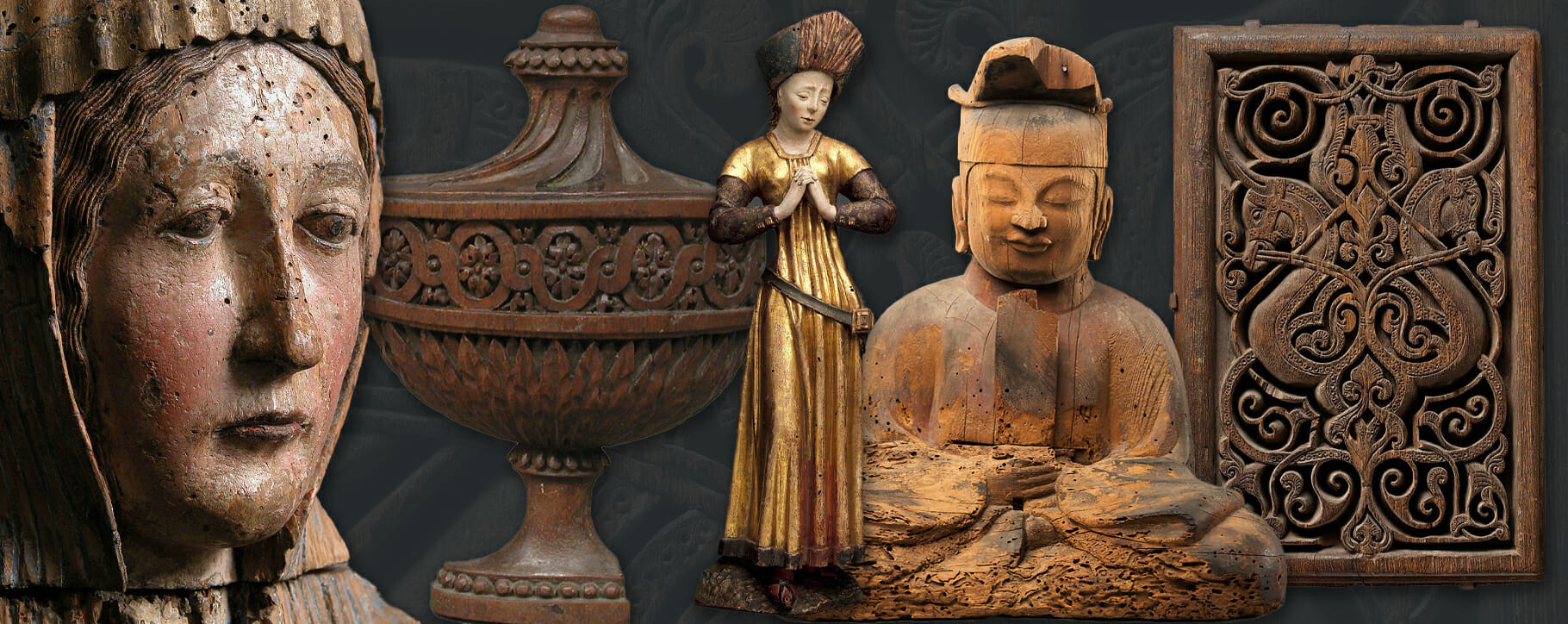 Above: a selection of wooden antiques from various eras
Above: a selection of wooden antiques from various eras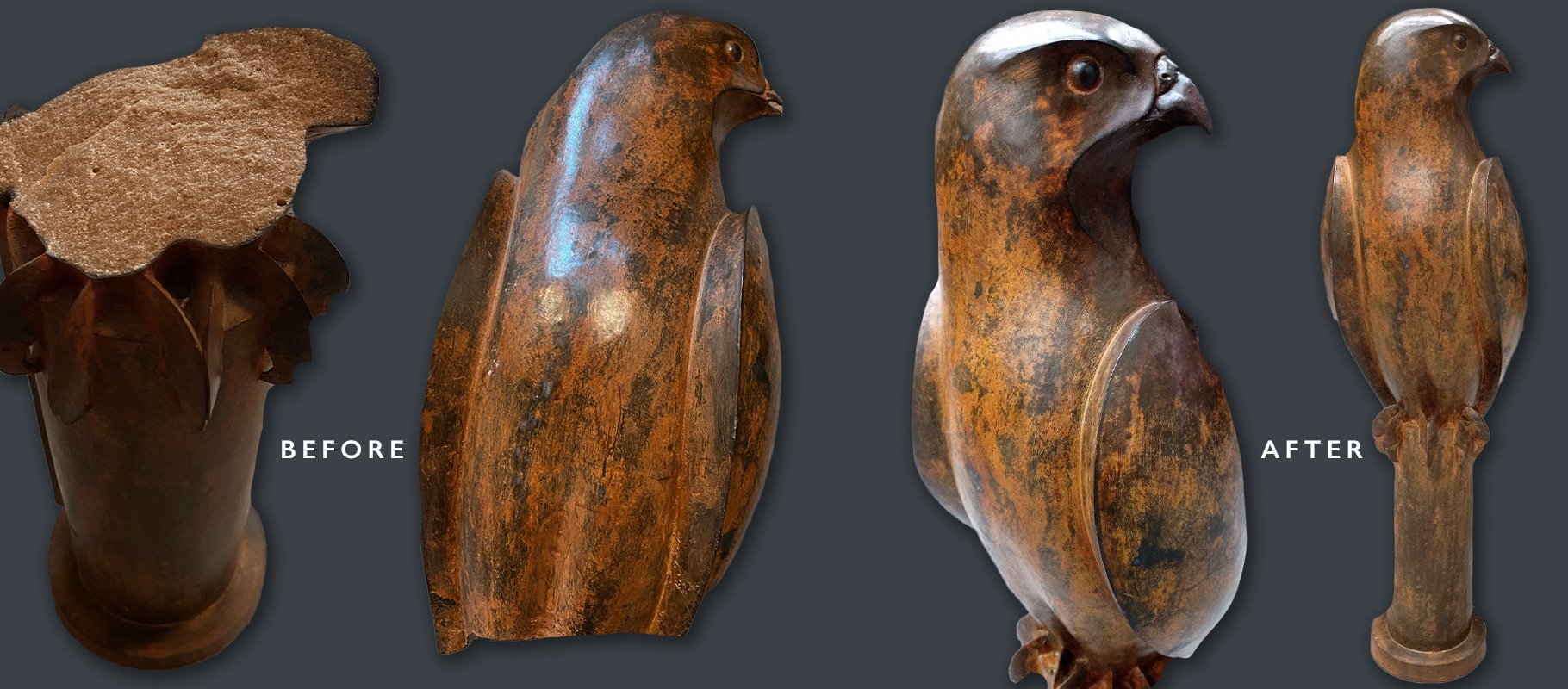 Above: a wooden sculpture that was restored in our studio
Above: a wooden sculpture that was restored in our studio Above: a selection of wooden sculptures from the 17th and 18th centuries
Above: a selection of wooden sculptures from the 17th and 18th centuries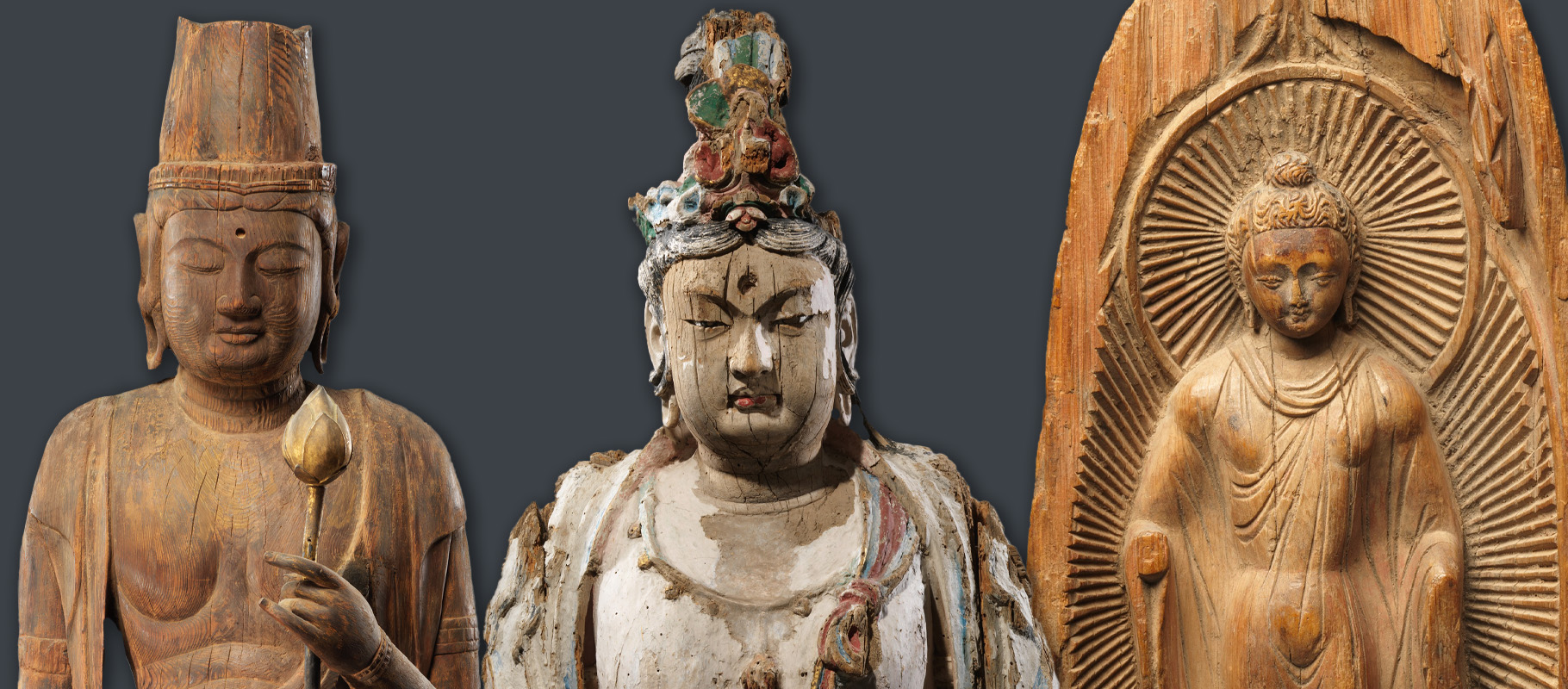 Above: from left to right Bodhisattva Kannon (Japanese, 11th century), Attendant Bodhisattva (Chinese, 10th-11th century), Buddha with radiate halo and mandorla (Chinese, 5th-6th century)
Above: from left to right Bodhisattva Kannon (Japanese, 11th century), Attendant Bodhisattva (Chinese, 10th-11th century), Buddha with radiate halo and mandorla (Chinese, 5th-6th century) Above: three reliquary busts with painted and gilt decoration, 16th century
Above: three reliquary busts with painted and gilt decoration, 16th century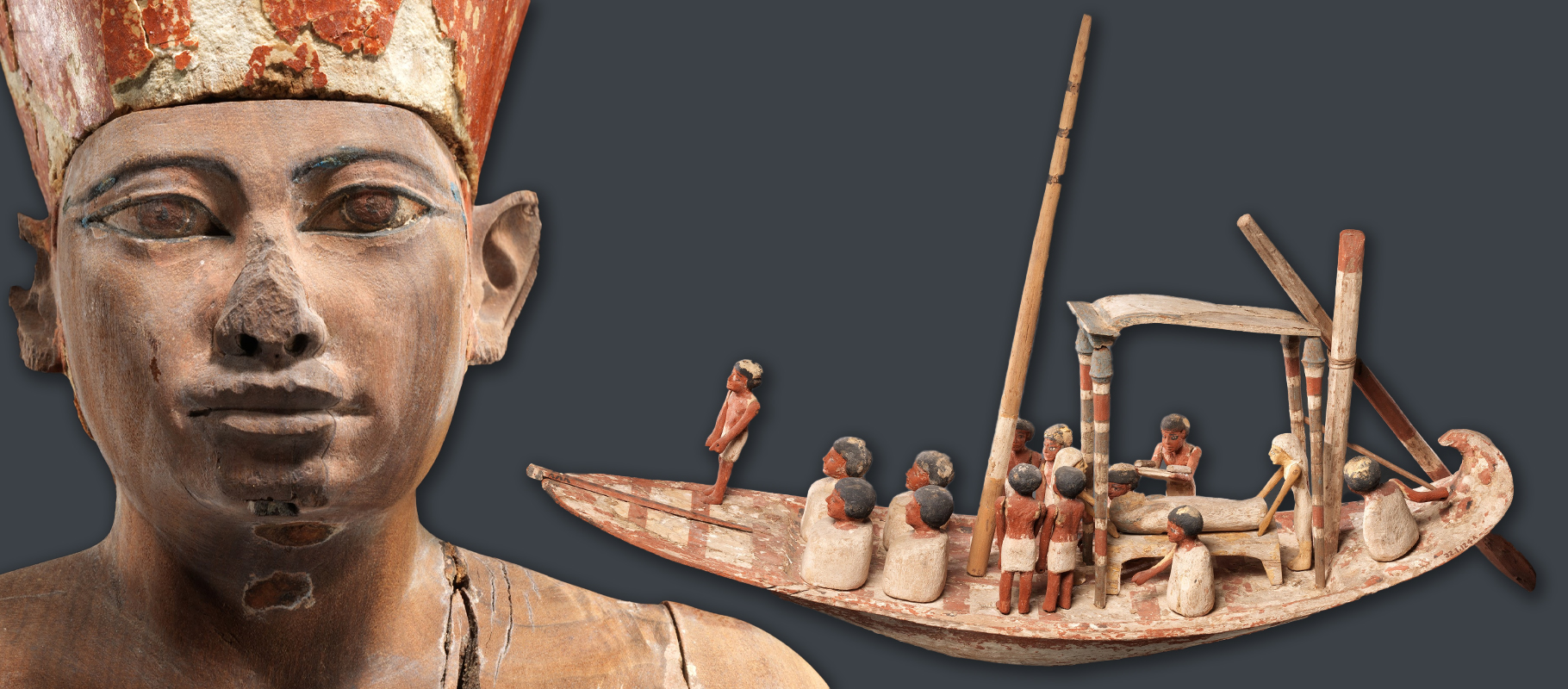 Above: wooden sculptures from Ancient Egypt where a
Above: wooden sculptures from Ancient Egypt where a 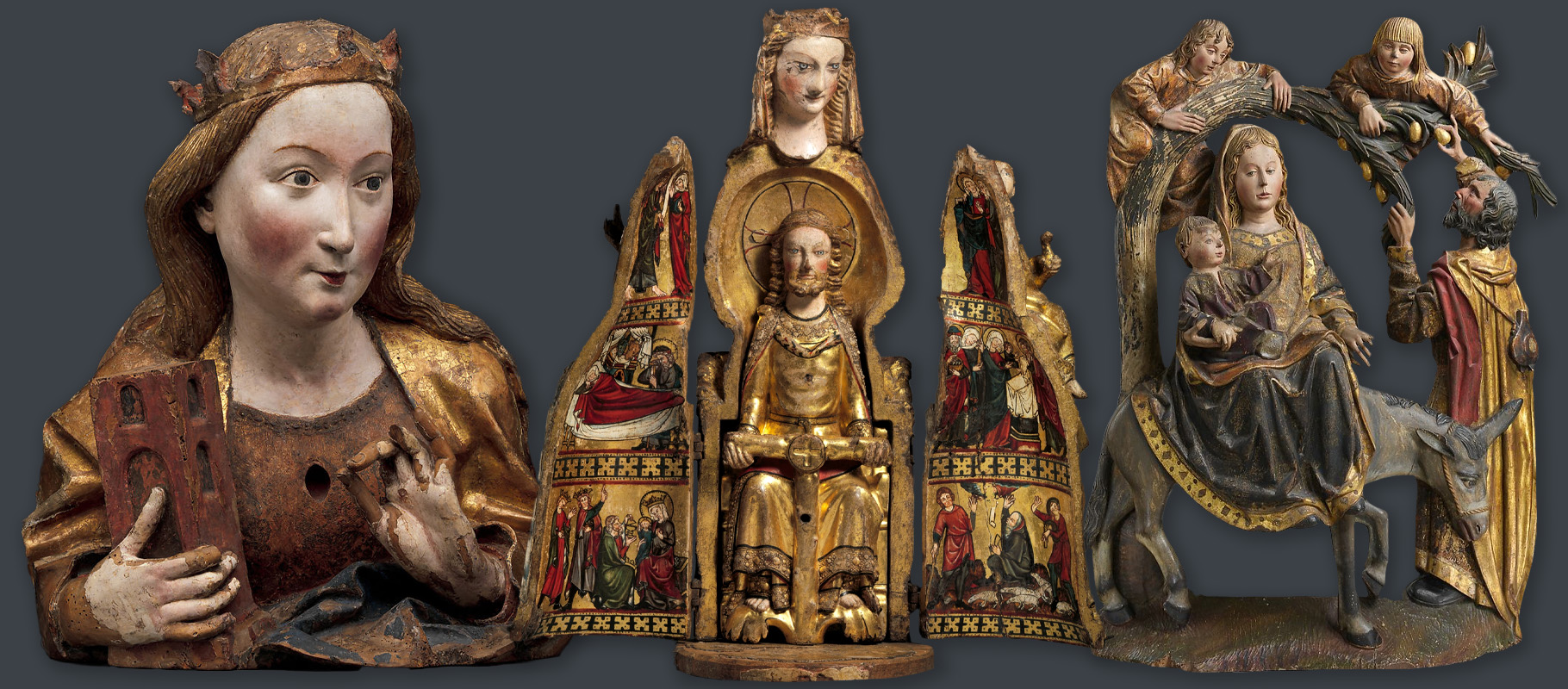 Above: a reliquary bust of Saint Barbara (1465), a shrine of the Virgin Mary (1300) and a sculpture of the flight into Egypt (1490-1510)
Above: a reliquary bust of Saint Barbara (1465), a shrine of the Virgin Mary (1300) and a sculpture of the flight into Egypt (1490-1510) Above: painted wooden sculptures such as these may fade if left in direct sunlight or strong artificial light
Above: painted wooden sculptures such as these may fade if left in direct sunlight or strong artificial light Above: two wooden sculptures with signs of historic woodworm infestation
Above: two wooden sculptures with signs of historic woodworm infestation




